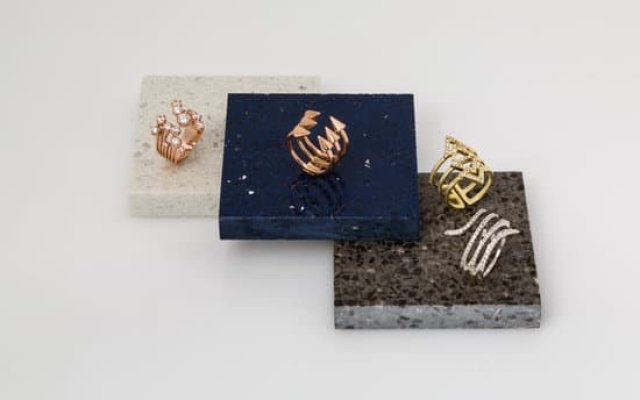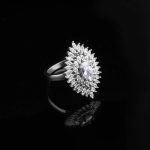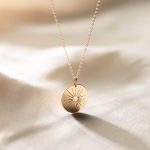Natural materials to make stone jewelry are a great way to turn jagged pieces of stone into beautiful pieces of art. Creating handmade jewelry with these raw materials makes each item unique and one of a kind.
Not only does it create unique pieces, but it also uses simple materials that won’t be too costly like wires, stones, adhesives, and paints. It enables people from all kinds of backgrounds to get creative with their jewelry-making without having to spend over their budget on tools or supplies.
Using Simple Tools To Create Stone Jewelry To get started with making stone jewelry, there is no need for expensive equipment or tools. All that’s needed is a few basic items such as pliers, wire cutters, beading thread, and some glue. Of course these items can vary depending on the type of project being made.
The most important part of the process is finding natural stones that fit perfectly with the design in mind. Once these items are gathered, cutting and shaping the stones will come next while incorporating other mediums like wood or metal for additional texture and detail if desired.
Displaying Along With Other Jewelry Pieces Making stone jewelry highlights the beauty in nature by its unique shapes and patterns using raw material from earthy elements like rocks and crystals. The goal when displaying the final piece should be focusing on featuring all that nature has already provided while putting an artistic spin to it through your own workmanship skills instead of relying heavily on colorful paints or bedazzled details.
Whether it be as a set alongside other matching pieces or individually placed atop textile fabric for added interest, showcasing this one-of-a-kind art has never been more fun.
Advantages of Making Stone Jewelry With Natural Materials
1. Versatility: Natural materials can be used to create unique and eye-catching pieces of jewelry with a wide variety of colors, shapes, sizes, textures, and finishes achievable. Not only do more natural-looking materials provide an organic look to the item being crafted, but they also offer an element of surprise when something unexpected emerges from its organic origins.
2. Affordability: Natural materials are widely available and generally more affordable than synthetic gems and stones which allows for individual’s with even tight budgets either purely craft or customize their own stone jewellery creations affordably. As most natural materials come in larger quantities than synthetic gemstones or beads this can often help you save money when creating items with them as less individual pieces are needed.
3. Durability: Many natural materials such as certain types of wood, petrified wood, slate/slate beads, agate slices/beads can last years or even generations when properly looked after, making them cost effective in the long run depending on what is being crafted from them.
Types of Natural Materials For Making Stone Jewelry
- Pebbles and Rocks
- Minerals such as Agates
- Crystals
- Wood Beads
- Ceramic Beads
- Shell Beads
<
Popular Natural Stones Used for Making Jewelry
Jewelry made with natural stones is often seen as special since they are unique and one of a kind.There are a variety of beautiful and eye-catching natural stones that can be embedded in metal to create exquisite jewelry. Popular examples include agate, amethyst, jasper, lapis lazuli, malachite and turquoise.
Agate
Agate is a naturally occurring quartz which comes in various colors and streak patterns ranging from white to deep green. It has been used for making decorations since ancient times due to its uniqueness and beauty.
Agates have become popular for use in rings, earrings, necklaces and other types of jewellery due to its numerous varieties of color combinations and beautiful patterning. Some agates contain hollow cavities filled with quartz crystals or gas bubbles which give the stone its unique look.
Amethyst
Amethyst is a semi-precious stone known for its violet hues ranging from pale lavender to deep adamant purple. It is most common found in Brazil but can also be found in some other parts of the world such as Bolivia, India, Zambia and Mexico. If heated to high temperatures Amethyst may form prisms which gives off spectacular colors when exposed to light.
This makes it perfect for making brooches, earrings and even necklaces as it adds an attractive glow to the jewelry when exposed to light. The powers associated with Amethyst make it more desirable when you want your jewelry item to have spiritual significance.
Jasper
Jasper is an opaque chalcedony which displays unique color bands arranged in striking patterns that makes it very aesthetically pleasing. It generally comes with earthy tones like reds, browns, yellows white etc but some special types come only specific areas around the world and display vibrant blues greens purples etc, These rare forms are considered more valuable than the ordinary types as they come with amazing features not seen before.
Jasper can also found naturally forming patterns like flower petals or shells,This is why its often used for making pendants beads bracelets rings etc, Its qualities give an extra edge that no manmade stones will be able match.
Tips For Finding the Best Natural Stones For Jewelry Making
Creating a one-of-a-kind stone necklace or set of earrings using natural gemstones can be both a beautiful and rewarding experience. There are many types of stones that can be used to make jewelry, but some are especially well-suited for crafting gorgeous pieces with the right care. Here are some tips on the best natural stones for creating stunning jewelry:
Turquoise
This semi-precious blue green stone is ideal for creating one-of-a-kind statement pieces due to its vibrant hue and unique patterns. Turquoise has been widely used since ancient times in making jewelry, thanks to its long history of being admired for its beauty and spiritual significance. The smooth texture gives it a luxurious feel, while the bold colors allow it to stand out amongst other natural materials. Its durability also makes it suitable for everyday wear jewelry.
Moonstone
Another sought-after stone in jewelry making is Moonstone, as this unique pearlized gem comes in shades of blue, pink, yellow and olive green which adds another layer of uniqueness to accessories made from this precious material. It has been known as a symbol of love, femininity and fertility throughout history and is renowned as mysterious and magical due to its characteristic bleumoonate effect when exposed to certain types of light.
Combining moonstone with other natural elements such as silver or gold makes for stylish and sophisticated item of jewelry that will last a lifetime.
Opal
Opal is an ideal choice for creating distinctive pieces that feature this dazzling multi colored stone Due to its ability to diffuse light giving it an iridescent appeal opal has sometimes been referred to as “the painting stones”. Available in various hues including white, rose quartz pink, greens blues they come in all sizes including small chips.
How To Cut, Polish, and Drill Natural Stones for Jewelry Making
Creating jewelry from natural stones can be a beautiful and rewarding craft, so it is important to know how to drill, cut, and polish the material. Knowing the mechanics of working with these stones will result in more successful jewelry pieces. With a few tools and plenty of practice, it will be easy to make stunning stone jewelry creations in no time.
Tools Needed
- Jeweler’s saw (frame saw)
- Sandpaper
- Dremel tool
- Drill bit or diamond core burrs
- Polishing pads/diamond polishing paste
First, you should secure the stone you wish to cut before attempting it by attaching or clamping it into a vice or jig. If setting up your own jig there are various designs available online or design your own that works best for your needs. You can also tape the edges of the stone while clamping it into place to help keep fingers safe from slipping as well as reduce wear on soft stones.
Then begin cutting using a jeweler’s saw and appropriate blade size for the stone shape. It is helpful to use pliers when making small inner cuts.
Be sure to take time during this process as broken pieces cannot easily be pieced back together without ruining its structure or appearance. Upon completing the cut on all sides, use sandpaper wrapped around an egg shape object and slowly work around each side until all sharp edges are gone.
The angle/grind settings used will determine how much of an edge will remain afterwards. If you need further refinement, use a Dremel tool with different burr sizes or sandpaper grits for contours and fine details on curves or recesses in stones such as cabochons or spheres.
Drilling & Polishing Stones For Jewelry Making
To remove any rough spots from the surface after drilling and polishing with a Dremel (or manual) drill bit (or diamond-core burrs), use polishing pads along with water/soapy water for diamonds or diamond polishing paste for softer semi-precious and gemstones such as turquoise, lapis lazuli etc. As you move gradually through finer grades of grits continue adding water/soapy water until desired shine is achieved at the end.
This same procedure applies when buffing facets onto faceted gemstones too when using flat laps throughout each stage eliminating any imperfections left over before moving onto finer grades. Either way, given enough practice taking one step at time by following these simple steps it make perfect sense then great sense without looking like modern day alchemy happening at first glance.
Tips For Working With Natural Stones For Jewelry Making
When working with natural stones for jewelry making here are some essential tips: wear safety glasses; always start drilling in reverse; lubricate hole often while drilling; don’t overheat gemstones when drilling; mark carefully where holes need to go before removing protective layers off gems; wash pebbles prior if necessary to reveal any veins/spots they may conceal at first glance.
Also remember not every gemstone is suitable for every type of setting so test samples in advance prior selecting materials you can actually craft successfully which also fits inside metal frames properly that’s structurally sound too eventually after completion.
Finally take frequent breaks when tackling challenging tasks – this helps prevent fatigue from building up too much.
Guide To Assembling Jewelry Pieces Using Natural Resources
Making jewelry out of natural stones can be an exciting and creative process. It is a great way to create your own unique pieces using stones that you have found or collected yourself. Natural stones come in a variety of shapes, colors, and sizes which make them perfect for use in jewelry making.
From the traditional look of opaque beads to the contemporary style of rough-cut pieces, creating stone jewelry presents many options. Here is a guide on how to assemble your jewelry pieces using the different types of natural resources available:
The most common material used for stone jewelry is semiprecious or precious gemstones. Precious stones are usually cut into small cabochons to be more versatile and easy to work with when stringing beadwork or creating wire-wrapped creations. You can purchase pre-cut stones from most craft stores, gemstone dealers, or online retailers. If you want a truly unique finish to your piece, look up lapidaries who specialize in cutting and polishing gemstones specifically for jewelers.
If you’re looking for something more rustic than gemstones, try making jewelry from pebbles or rocks. Many craft stores sell smooth river rocks that come in bulk for low prices that are perfect when combined with leather cord or stranded silk thread for beaded wrap necklaces.
You could also search beaches on vacations for sea glass which looks beautiful when strung together with silver jump rings as charms for special occasions like summer weddings or festivals (or just as a statement piece).
Wooden beads can add an interesting touch to any collection too. Rich browns plus warm rustic reds and yellows, along with many other shades will add texture and depth to earrings and necklaces – simply use glue to secure wood bead caps onto strong wire so they don’t slide off easily during wear.
Another material worth exploring is bone; conical spacers lacquered with bright colors plus drilled discs full of carvings all help give character even in simpler designs. Lastly, hand-carved shells such as abalone can appear as little works of art themselves – if left raw they can showcase patterns more naturally too.
Unique Stone Jewelry Designs and Creation Process
Stone jewelry is a popular choice for many people due to its variety of styles, colors, and stones used. The process of creating stone jewelry by hand involves selecting the right material and designing a piece that fits the user’s individual taste. Natural materials can be used to create stunning pieces of jewelry with a unique appeal. Here are some of the natural materials one can use to make stone jewelry:
- Crystals
- Gemstones
- Natural metals
- Fossils
- Organic Materials
Each of these natural materials offers various properties and unique characteristics that can be incorporated into stone jewelry designs. Crystals, for instance, are often associated with spiritual energies while gemstones are prized for their beauty and energy fields. Natural metals like gold and silver have long been used in traditional jewelry pieces for embellishment and details such as prongs or settings.
Fossils provide an interesting element to any design through their unusual shapes and textures which range from smooth to rough. Organic materials such as feathers, wood, bone, ivory, shells or nuts offer extraordinary visual appeal when incorporated into stone pieces.
The creation process begins with selecting the desired material out of the list above followed by careful measuring and cutting it into the desired shape using specialized tools like saws, rotary cutters, chisels or sanders. After that, the artist might choose to polish the stone for higher levels of sheen which helps bring out its qualities better due to improved color saturation and clarity as well as decreased fissures on its surface area.
Once a piece is ready it is then fit onto the metalwork portion to form either a pendant or other type of jewelry item depending on how it was designed originally. Lastly proper cleaning and sealing techniques should be employed before wearing or displaying your finished product in order to protect it against dirt build-up which might eventually damage it over time if left unchecked properly.
Why Investing In Natural Materials For Your Jewels Is a Smart Choice
If you’re looking for the perfect jewelry piece, why not consider making it yourself using natural materials? Incorporating natural elements into your jewels is an excellent way to give them a unique, personal touch. Natural materials like stones and crystal create delicate, elegant pieces with an undeniably earthy feel. Let’s look at some of the advantages of investing in natural materials for your jewelry-making projects.
Unique Beauty
Natural gemstones and crystals have long been a symbol of beauty and luxury. As part of handmade jewelry pieces, they offer limitless design options – from classic designs to modern boho styles. Every stone is unique and has its own individual properties, making each jewel truly one-of-a-kind. Whether you’re creating pendants or rings, bracelet charms or earrings, incorporating natural gems helps each piece stand out. Plus their unique color combinations can add vibrancy to your jewelry collection.
Durability & Longevity
Due to their durability and strength, stones make exceptional components for genuine jewelry pieces that last through time. A stone necklace or ring made with correctly treated gemstones should keep its beauty-and value-intact for years on end without losing any value due to changing trends or fading colors.
Investing in longer lasting pieces also allows fashion savvy customers cut down on overall expenses in the long run due to finding a better rate over buying cheap fashion items every season which are easily replaced with more options by simply shopping around again the following season without trying too hard.
Opportunities For Customization
Using natural materials such as semiprecious stones also provides a great opportunity for creativity and customization when creating your own jewelry pieces. Whether it be through beautifully set sterling silver settings or combination of various stones and hues – from amethyst to tourmaline – combining different gems together will truly represent an extension of you and what you care about most while remaining fashionable under all circumstances.
Working with these magical minerals can help discover new ways to express yourself during special events as well as throughout everyday life. It is this type of creative expression that cannot be substituted by conventional products found on store shelves without having visited them first hand.
Care Guidelines For Natural Stones Jewelry Pieces
When it comes to stone jewelry, natural materials have been used for centuries as traditional elements in making stylish pieces. Natural stones such as turquoise, opal and pearl are some of the most popular stones used in jewelry because they are beautiful and durable. Before wearing or cleaning stone jewelry, there are a few care guidelines that should be followed to ensure the piece is kept looking its best.
The first step is to choose a cleaning solution suitable for the material of the piece. Generally speaking, plain soap and warm water is a safe option that won’t damage many types of stones unless otherwise specified. It’s important to stop using any harsh chemicals on your pieces as these can make them more porous which can lead to further damage down the line.
It’s also advisable to use only lukewarm or slightly warm water when wetting your jewelry at any stage – never hot water. Hot water can cause some natural stones to crack or fade in color over time, so it’s better avoided if possible. Once you’ve finished cleaning your item, be sure to dry it well with a soft cloth.
General Care Guidelines To Follow
- Choose a suitable cleaning solution for the material being used
- Avoid using harsh chemicals
- Use lukewarm or slightly warm water when wetting your jewelry
- Dry your item well after cleaning with a soft cloth
Conclusion
Stone jewelry is a popular accessory for many people who want to create a unique and interesting look. Natural materials such as stones, crystals, wood, fossils, bone, and shells have been used for centuries to craft beautiful and one-of-a-kind pieces of jewelry. Each piece will be unique and special since no two pieces of stone are the same.
When purchasing natural stone jewelry, you can select the colors, shapes, textures, and sizes that best match your own taste and style. By using these materials as well as wire wrapping or stringing techniques to craft custom pieces you can truly make something truly original that no one else will have.
The process of crafting stone jewelry usually begins with selecting the type of stone that you would like to use. You’ll want to consider factors such durability when selecting your stones since metals age differently than stones do in terms of color fading or scratches over time.
Once your materials are selected then you’ll need to decide on a design or pattern for your piece. This part is completely customizable to individual tastes and styles so you can choose from a wide variety of options from freeform abstract designs to more structured patterns inspired by traditional jewelry techniques.
With a few basic tools such as wire cutters, small pliers, tweezers, files, hammer/anvils/mallet combinations sets you can easily transform natural elements into wearable pieces of art which can last a lifetime if cared for properly. The best thing about creating your own unique designs from natural materials is knowing that they will never go out of style due to their timeless beauty and elegance.
With patience and care invested into each piece crafted with natural materials they will make fantastic heirloom quality gifts or additions to your accessory collection.

Welcome to my jewelry blog! My name is Sarah and I am the owner of this blog.
I love making jewelry and sharing my creations with others.
So whether you’re someone who loves wearing jewelry yourself or simply enjoys learning about it, be sure to check out my blog for insightful posts on everything related to this exciting topic!





